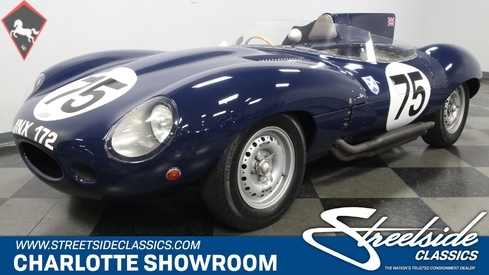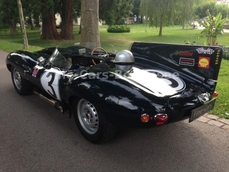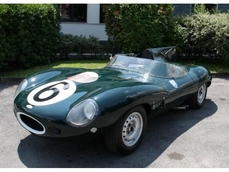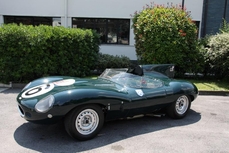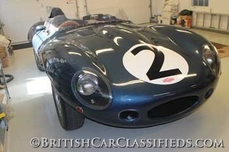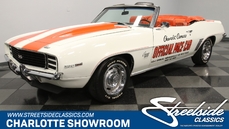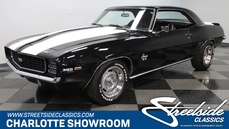Jaguar D-Type Replica 3.8 Liter H6 1960
General description :
Description
This 1960 Jaguar D-Type replica is a full performance build - right down to the sound of the side pipes. So dig into all the details on a sleek high-quality retro machine that will make your favorite roads feel like Le Mans.
If you are going to get a replica of a D-Type, this is the exact way to do it. The long-nose version in a deep blue Ecurie Ecosse livery makes it a ringer for the winner of the 1956 24 Hours of Le Mans. This is a RAMLM kit, and it was built quiet nicely. It's a faithful English-built tribute that has the swoopy fenders, power bulge hood, Lexan racing windshield, and single offset tailfin to try and streamline the driver as best as possible. This is well-detailed package, right down to the replica Dunlop racing wheels and Pirelli Cinturato tires.
The interior is pure racecar. The seat is contoured to the racing tub; there's a wood-rimmed steering wheel on a quick release column; and the shifter is in the riveted metal center section. Oh yes, this absolutely feels like a proper open-top vintage racer. There's even a full Smiths gauge package, and the large speedo and tach are correctly reversed. And for those times when you want to share the fun with someone else, the side hard tonneau can be removed and you have a proper door, seat, and seatbelt for a passenger.
One of the great things about owning a quality replica is you get a vintage style, but with some very handy improvements. When you tilt the whole front end forward, you get the unmistakable look of Jaguar's awesome DOHC XK motor. It's a clean presentation where everyone gets to see great race-ready details, like the triple set of dual-barrel Weber carbs. But while the original D-Types were limited to 3442cc, this has a larger 3.8-liter powerhouse. It fires up with a powerful sound out of the split exhaust header that exits opposite the driver. You'll love tuning in this wonderful motor's soundtrack using the racing style throttle blips to shift the four-speed manual transmission. This is built on a strong steel chassis with modern shocks. Plus, while the D-Type had to have a live rear axle, this benefits from one of the greatest rear suspension ever made: the Jaguar independent rear end that debuted on the E-type. Not only is it considered one of the strongest setups around, but also it has inboard disc brakes for better weight distribution.
The sale comes complete with paperwork including maintenance records, service manuals, receipts, and a log book. This is the quality build that gives you the look of a multi-million-dollar classic, and it even offers an upgraded experience of a true racecar feeling. So if you know how special this car is, then you know this is a fleeting opportunity. Call now!
Features : Four Wheel Disc Brakes , Seatbelts , Vinyl Interior ,
https://www.streetsideclassics.com/vehicles/6015-cha/1960-jaguar-d-type-replica
1960 Jaguar D-Type Replica 3.8 Liter H6 is listed sold on ClassicDigest in Charlotte by Streetside Classics for $99995.
Car Facts
Car type : Car Make : Jaguar Model : D-Type Model Version : Replica 3.8 Liter H6 Engine size : 3.8 Model Year : 1960 Location : Charlotte
Sold
Seller Information
Sold
People who viewed this Jaguar D-Type also viewed similar Jaguar listed at ClassicDigest
Other cars listed for sale by this dealer
About Jaguar
Ah, the story of Jaguar, from its early days as the SS Cars Ltd. to its pinnacle with the D-type, and the street-going evolution in the form of the iconic E-type. There's something quintessentially British about this tale, and I'll narrate it as a British journalist might.In the Beginnings:
Our journey into the world of Jaguar begins in the 1930s, when a company known as SS Cars Ltd. emerged. Despite the unfortunate coincidence of their initials with the rising political tensions in Europe, they started producing stylish and performance-oriented cars. The SS 100, introduced in 1936, was a symbol of elegance and speed, setting the stage for what would become Jaguar.
The Birth of Jaguar:
As the shadows of World War II loomed, SS Cars Ltd. wisely decided to disassociate themselves from the SS initials. Thus, in 1945, they officially became Jaguar Cars Ltd., a name that would soon be synonymous with British luxury and performance.
The XK Series:
Jaguar's post-war era brought us the XK 120, a true sensation in 1948. With its sleek design and a powerful 3.4-liter inline-six engine, it became the world's fastest production car. The XK 120 was the blueprint for what lay ahead – Jaguars that blended style with speed in a uniquely British fashion.
The D-type Dominance:
Then came the D-type, a true racing legend. Introduced in 1954, it won Le Mans three times in the 1950s, showcasing Jaguar's engineering prowess. With its innovative monocoque construction and the iconic fin at the back, the D-type was the apex of Jaguar's motorsport success.
The E-type Emergence:
But the true turning point arrived in 1961 with the introduction of the E-type, often described by Enzo Ferrari as "the most beautiful car ever made." Its long bonnet, curvaceous body, and a 3.8-liter engine delivering exhilarating performance made it an instant classic. The E-type was not just a car; it was a work of art on wheels, and it could hit 150 mph on the road.
Street and Racing Success:
The E-type's beauty was matched by its capability on the track. The lightweight E-types were particularly successful in various racing events, cementing Jaguar's reputation as a force to be reckoned with in motorsport.
The Age of Refinement:
As we delve deeper into the Jaguar story, we find that the 1950s and 1960s were an age of refinement and expansion. Alongside the magnificent D-type and the E-type's iconic emergence, Jaguar introduced models that further solidified its reputation for luxury and performance.
The MK2:
In the late 1950s, Jaguar unveiled the MK2, a sports sedan that combined elegance with power. This sleek four-door saloon was a favorite of bank robbers and law enforcement alike, thanks to its exceptional speed and handling. The MK2 was a symbol of Jaguar's ability to blend sophistication with performance and had a successful racing career as well.
The XJ6:
Fast forward to 1968, and Jaguar launched a car that would define luxury saloons for decades to come – the XJ6. It was a masterpiece of engineering and design, featuring a smooth inline-six engine, independent rear suspension, and a spacious, beautifully appointed interior. The XJ6 was a symbol of British elegance and provided a ride so smooth that it seemed to glide over the road. It became the flagship model for Jaguar and set the standard for luxury saloons, showcasing a level of refinement that left competitors in awe.
The Blend of Classic and Modern:
While the MK2 and XJ6 represented the evolution of Jaguar's saloon cars, they maintained the brand's commitment to performance and luxury. These cars didn't just belong on the racetrack; they were equally at home cruising down the grand boulevards or gliding through the English countryside.
The Challenges of Change:
However, as the 1970s arrived, Jaguar, like many British automakers, faced financial challenges and changes in ownership. The British Leyland era brought both opportunities and struggles, as the brand navigated through various mergers and transitions.
Nevertheless, the legacy of the MK2 and XJ6, along with the D-type and E-type, continues to define Jaguar as a manufacturer that combines timeless elegance with a spirit of performance. These classic models, whether driven on winding roads or parked as collectors' treasures, serve as a testament to Jaguar's enduring presence in the world of automotive excellence.
The Jaguar story, from its early days as SS Cars Ltd. to the creation of automotive icons like the E-type, MK2, and XJ6, is a journey that reflects the very essence of British motoring – a blend of luxury, power, and style that continues to captivate enthusiasts and connoisseurs alike.
